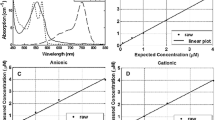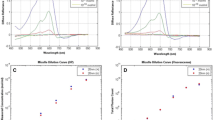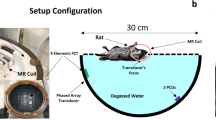Abstract
Nanoparticles such as liposomes may be used as drug delivery vehicles for brain tumor therapy. Particle geometry and electrostatic properties have been hypothesized to be important determinants of effective tumor targeting after intraarterial injection. In this study, we investigate the combined roles of liposome size and surface charge on the effectiveness of delivery to gliomas after intraarterial injection. Intracarotid injection of liposomes was performed in separate cohorts of both healthy and C6 glioma-bearing Sprague Dawley rats after induction of transient cerebral hypoperfusion. Large (200 nm) and small (60–80 nm) fluorescent dye-loaded liposomes that were either cationic or neutral in surface charge were utilized. Delivery effectiveness was quantitatively measured both with real-time, in vivo and postmortem diffuse reflectance spectroscopy. Semi-quantitative multispectral fluorescence imaging was also utilized to assess the pattern and extent of liposome targeting within tumors. Large cationic liposomes demonstrated the most effective hemispheric and glioma targeting of all the liposomes tested. Selective large cationic liposome retention at the site of glioma growth was observed. The liposome deposition pattern within tumors after intraarterial injection was variable with both core penetration and peripheral deposition observed in specific tumors. This study provides evidence that liposome size and charge are important determinants of effective brain and glioma targeting after intraarterial injection. Our results support the future development of 200-nm cationic liposomal formulations of candidate intraarterial anti-glioma agents for further pre-clinical testing.






Similar content being viewed by others
References
De Baere T, Mariani P. Surgical or percutaneous hepatic artery cannulation for chemotherapy. J Visc Surg. 2014;151 Suppl 1:S17–20. doi:10.1016/j.jviscsurg.2013.12.004.
Drummond DC, Meyer O, Hong K, Kirpotin DB, Papahadjopoulos D. Optimizing liposomes for delivery of chemotherapeutic agents to solid tumors. Pharmacol Rev. 1999;51(4):691–743.
Joshi S, Singh-Moon R, Wang M, Bigio IJ. Transient cerebral hypoperfusion assisted intra-arterial delivery of mitoxantrone in C6 glioma bearing rats. J Neurosurg Anesthesiol. 2014;26(4):482.
Joshi S, Singh-Moon RP, Ellis JA, Chaudhuri DB, Wang M, Reif R, et al. Cerebral hypoperfusion-assisted intra-arterial deposition of liposomes in normal and glioma-bearing rats. Neurosurgery. 2015;76(1):92–100. doi:10.1227/NEU.0000000000000552.
Hossain SS, Hughes TJ, Decuzzi P. Vascular deposition patterns for nanoparticles in an inflamed patient-specific arterial tree. Biomech Model Mechanobiol. 2013. doi:10.1007/s10237-013-0520-1.
Hossain SS, Zhang Y, Liang X, Hussain F, Ferrari M, Hughes TJ, et al. In silico vascular modeling for personalized nanoparticle delivery. Nanomedicine. 2013;8(3):343–57. doi:10.2217/nnm.12.124.
Liu Y, Shah S, Tan J. Computational modeling of nanoparticle targeted drug delivery. Rev Nanosci Nanotechnol. 2012;1:66–83.
Joshi S, Singh-Moon R, Wang M, Chaudhuri DB, Ellis JA, Bruce JN, et al. Cationic surface charge enhances early regional deposition of liposomes after intracarotid injection. J Neuro-Oncol. 2014. doi:10.1007/s11060-014-1584-1.
Joshi S, Singh-Moon RP, Wang M, Chaudhuri DB, Holcomb M, Straubinger NL, et al. Transient cerebral hypoperfusion assisted intraarterial cationic liposome delivery to brain tissue. J Neuro-Oncol. 2014. doi:10.1007/s11060-014-1421-6.
Roy Chaudhuri T, Arnold RD, Yang J, Turowski SG, Qu Y, Spernyak JA, et al. Mechanisms of tumor vascular priming by a nanoparticulate doxorubicin formulation. Pharm Res. 2012;29(12):3312–24. doi:10.1007/s11095-012-0823-4.
Meers P, Ali S, Erukulla R, Janoff AS. Novel inner monolayer fusion assays reveal differential monolayer mixing associated with cation-dependent membrane fusion. Biochim Biophys Acta. 2000;1467(1):227–43.
Saito R, Bringas JR, McKnight TR, Wendland MF, Mamot C, Drummond DC, et al. Distribution of liposomes into brain and rat brain tumor models by convection-enhanced delivery monitored with magnetic resonance imaging. Cancer Res. 2004;64(7):2572–9.
Reif R, Wang M, Joshi S, A'Amar O, Bigio IJ. Optical method for real-time monitoring of drug concentrations facilitates the development of novel methods for drug delivery to brain tissue. J Biomed Opt. 2007;12(3):034036.
Arnold RD, Mager DE, Slack JE, Straubinger RM. Effect of repetitive administration of doxorubicin-containing liposomes on plasma pharmacokinetics and drug biodistribution in a rat brain tumor model. Clin Cancer Res. 2005;11(24 Pt 1):8856–65.
Biswas S, Dodwadkar NS, Deshpande PP, Parab S, Torchilin VP. Surface functionalization of doxorubicin-loaded liposomes with octa-arginine for enhanced anticancer activity. Eur J Pharm Biopharm: Off J Arbeitsgemeinschaft Pharmazeutische Verfahrenstechnik eV. 2013;84(3):517–25. doi:10.1016/j.ejpb.2012.12.021.
Gupta B, Levchenko TS, Torchilin VP. TAT peptide-modified liposomes provide enhanced gene delivery to intracranial human brain tumor xenografts in nude mice. Oncol Res. 2007;16(8):351–9.
Zhao M, Chang J, Fu X, Liang C, Liang S, Yan R, et al. Nano-sized cationic polymeric magnetic liposomes significantly improves drug delivery to the brain in rats. J Drug Target. 2012;20(5):416–21.
Zhao H, Li GL, Wang RZ, Li SF, Wei JJ, Feng M, et al. A comparative study of transfection efficiency between liposomes, immunoliposomes and brain-specific immunoliposomes. J Int Med Res. 2010;38(3):957–66.
Thole M, Nobmanna S, Huwyler J, Bartmann A, Fricker G. Uptake of cationzied albumin coupled liposomes by cultured porcine brain microvessel endothelial cells and intact brain capillaries. J Drug Target. 2002;10(4):337–44.
Wen CJ, Zhang LW, Al-Suwayeh SA, Yen TC, Fang JY. Theranostic liposomes loaded with quantum dots and apomorphine for brain targeting and bioimaging. Int J Nanomedicine. 2012;7:1599–611.
Dedrick RL. Arterial drug infusion: pharmacokinetic problems and pitfalls. J Natl Cancer Inst. 1988;80(2):84–9.
Joshi S, Meyers PM, Ornstein E. Intracarotid delivery of drugs: the potential and the pitfalls. Anesthesiology. 2008;109(3):543–64. doi:10.1097/ALN.0b013e318182c81b.
Joshi S, Wang M, Etu JJ, Nishanian EV, Pile-Spellman J. Cerebral blood flow affects dose requirements of intracarotid propofol for electrocerebral silence. Anesthesiology. 2006;104(2):290–8.
Joshi S, Wang M, Etu JJ, Suckow RF, Cooper TB, Feinmark SJ et al. Transient cerebral hypoperfusion enhances intraarterial carmustine deposition into brain tissue. Journal of neuro-oncology. 2007.
Abercrombie M, Ambrose EJ. The surface properties of cancer cells: a review. Cancer Res. 1962;22:525–48.
Dobrzynska I, Skrzydlewska E, Figaszewski ZA. Changes in electric properties of human breast cancer cells. J Membr Biol. 2013;246(2):161–6. doi:10.1007/s00232-012-9516-5.
Dobrzynska I, Szachowicz-Petelska B, Darewicz B, Figaszewski ZA. Characterization of human bladder cell membrane during cancer transformation. J Membr Biol. 2015;248(2):301–7. doi:10.1007/s00232-015-9770-4.
Marquez M, Nilsson S, Lennartsson L, Liu Z, Tammela T, Raitanen M, et al. Charge-dependent targeting: results in six tumor cell lines. Anticancer Res. 2004;24(3a):1347–51.
Blau S, Jubeh TT, Haupt SM, Rubinstein A. Drug targeting by surface cationization. Crit Rev Ther Drug Carrier Syst. 2000;17(5):425–65.
Lu W, Sun Q, Wan J, She Z, Jiang XG. Cationic albumin-conjugated pegylated nanoparticles allow gene delivery into brain tumors via intravenous administration. Cancer Res. 2006;66(24):11878–87. doi:10.1158/0008-5472.CAN-06-2354.
Lu W, Wan J, Zhang Q, She Z, Jiang X. Aclarubicin-loaded cationic albumin-conjugated pegylated nanoparticle for glioma chemotherapy in rats. Int J Cancer. 2007;120(2):420–31.
Mizuno M, Ryuke Y, Yoshida J. Cationic liposomes conjugation to recombinant adenoviral vectors containing herpes simplex virus thymidine kinase gene followed by ganciclovir treatment reduces viral antigenicity and maintains antitumor activity in mouse experimental glioma models. Cancer Gene Ther. 2002;9(10):825–9.
Thurston G, McLean JW, Rizen M, Baluk P, Haskell A, Murphy TJ, et al. Cationic liposomes target angiogenic endothelial cells in tumors and chronic inflammation in mice. J Clin Invest. 1998;101(7):1401–13. doi:10.1172/JCI965.
Campbell RB, Fukumura D, Brown EB, Mazzola LM, Izumi Y, Jain RK, et al. Cationic charge determines the distribution of liposomes between the vascular and extravascular compartments of tumors. Cancer Res. 2002;62(23):6831–6.
Stephens FO. Induction chemotherapy: to downgrade aggressive cancers to improve curability by surgery and/or radiotherapy. Eur J Surg Oncol: J Eur Soc Surg Oncol Br Assoc Surg Oncol. 2001;27(7):672–88. doi:10.1053/ejso.2001.1158.
Stephens FO. Induction (neo-adjuvant) chemotherapy: systemic and arterial delivery techniques and their clinical applications. Aust N Z J Surg. 1995;65(10):699–707.
Szachowicz-Petelska B, Sulkowski S, Figaszewski ZA. Altered membrane free unsaturated fatty acid composition in human colorectal cancer tissue. Mol Cell Biochem. 2007;294(1–2):237–42. doi:10.1007/s11010-006-9264-x.
Cooper I, Sasson K, Teichberg VI, Schnaider-Beeri M, Fridkin M, Shechter Y. Peptide derived from HIV-1 TAT protein destabilizes a monolayer of endothelial cells in an in vitro model of the blood-brain barrier and allows permeation of high molecular weight proteins. J Biol Chem. 2012;287(53):44676–83. doi:10.1074/jbc.M112.395384.
Author information
Authors and Affiliations
Corresponding author
Ethics declarations
Ethical standards
All the experiments reported comply with the current laws of the USA. All the experiments were approved by the Columbia University Institutional Review Board and the Animal Care and Use Committee.
Conflict of interest
The authors declare that they have no conflict of interest.
Funding
This study was funded by the National Cancer Institute at the National Institutes of Health RO1-CA-138643.
Rights and permissions
About this article
Cite this article
Joshi, S., Cooke, J.R.N., Chan, D.K.W. et al. Liposome size and charge optimization for intraarterial delivery to gliomas. Drug Deliv. and Transl. Res. 6, 225–233 (2016). https://doi.org/10.1007/s13346-016-0294-y
Published:
Issue Date:
DOI: https://doi.org/10.1007/s13346-016-0294-y




